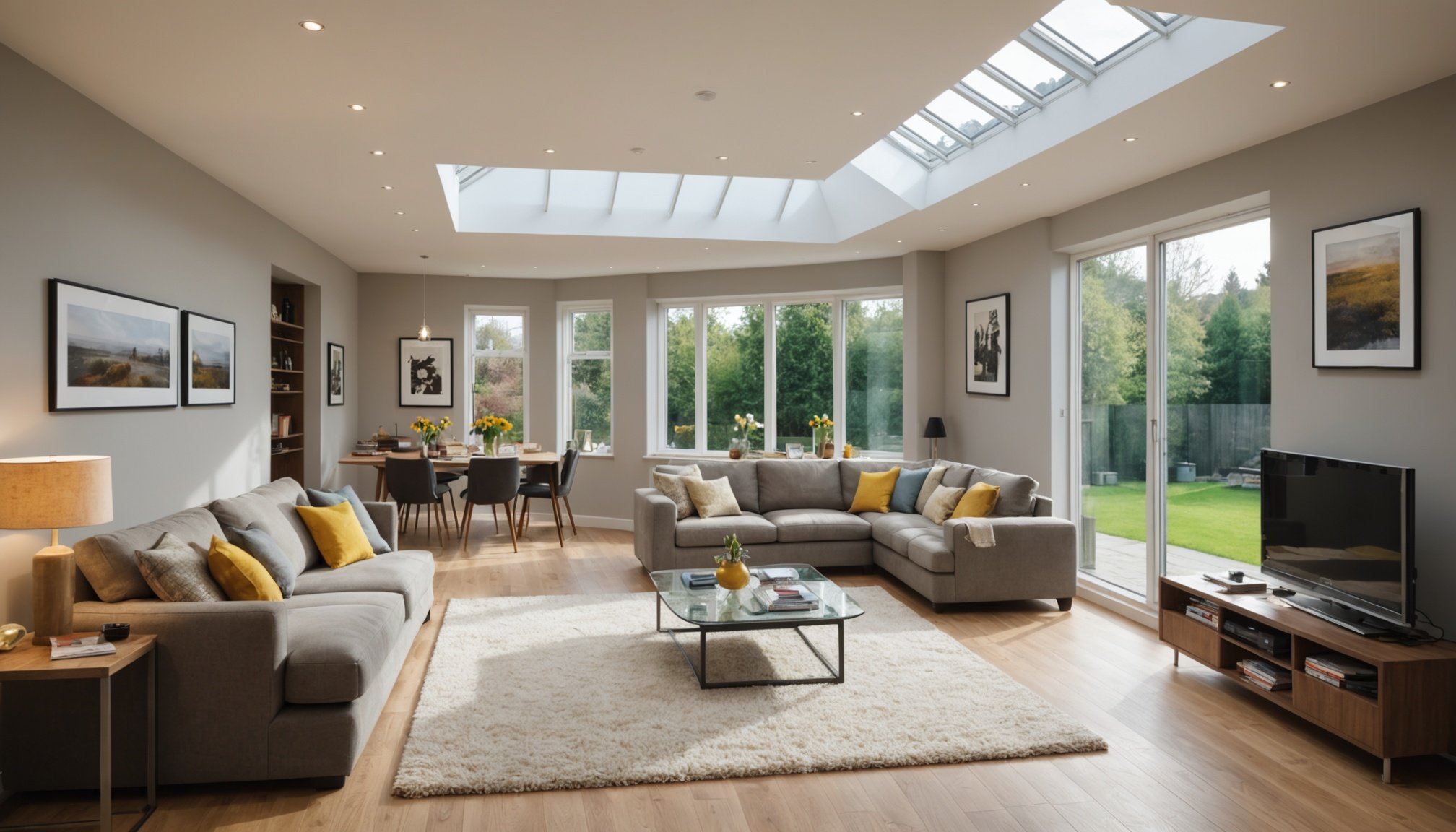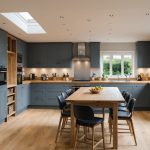Understanding the Importance of Natural Light in Basement Conversions
Natural light offers numerous benefits when it comes to basement conversions. Firstly, incorporating natural light into such spaces significantly enhances mental well-being. Exposure to sunlight is directly linked to improved mood and reduced stress, making your basement a more comfortable and inviting area to spend time in.
Secondly, natural light plays a crucial role in the perception of space. A well-lit basement can feel more expansive and less confined. It also contributes to the overall aesthetics by bringing out the colours and textures in the décor more vividly. This can transform a previously dim and uninviting area into a lively and appealing part of the home.
Have you seen this : Top Soundproofing Tips for Peaceful Living in UK Cities: Your Guide to Urban Serenity
Importantly, ensuring that your basement has adequate lighting can boost property value and appeal. A bright, airy basement is often more attractive to potential buyers, as it adds usable space and versatility to a property. Investing in solutions that maximize natural light not only improves daily living but is a valuable addition when considering future sales, leading to a potential home value enhancement.
Therefore, focusing on integrating natural light during basement conversions is both a beneficial personal and financial decision.
Also to see : Illuminating Art Nouveau: The Ultimate Guide to Lighting Architectural Features in Your UK Home
Innovative Design Strategies for Maximizing Natural Light
Incorporating natural light into your living space can significantly improve ambiance and energy efficiency. Below, explore the design tips that can help optimize the sunlight in your home.
Utilizing Open Floor Plans
Open layouts are instrumental in promoting the flow of light between spaces. By reducing walls and barriers, these plans allow for an unimpeded distribution of natural light, creating a bright and airy atmosphere. Opt for minimalistic furniture arrangements to complement this setup, ensuring that light can travel freely and enhance the spatial experience.
Integrating Glass Elements
The strategic use of glass can increase natural illumination considerably. Installing large windows and glass doors not only provides a direct source of sunlight but also establishes a seamless connection between indoor and outdoor environments. Consider ceiling-to-floor windows if possible, to maximize light intake and visibility.
Employing Reflective Materials
Reflective surfaces are a fantastic solution to brighten up dark corners. Use mirrors and shiny finishes on walls or furniture to effectively bounce light throughout your room. When selected thoughtfully, these materials can amplify luminosity without overpowering the existing decor, making them a versatile design tip to consider.
Structural Modifications for Enhanced Light Entry
Incorporating skylights can significantly influence the light dynamics within a building. Skylights act as a direct pathway for sunlight, efficiently illuminating spaces throughout the day. Not only do they provide natural light, but they also create an open, airy feel.
Moving to below-ground spaces, the addition of below-ground windows offers a valuable method for accessing natural light. These windows are strategically placed to maximise exposure, especially effective in basements. By allowing daylight to filter through, the rooms feel less enclosed and gloomy.
A more comprehensive approach involves constructing light wells. Light wells are designed to capture and channel sunlight into lower levels of a building, including basements. By reflecting light downwards, these structures can dramatically enhance the brightness and ambiance of spaces often deprived of natural light. Light wells may require structural adjustments, but the benefits of increased illumination outweigh these challenges.
Building owners can mix and match these strategies to optimise natural light exposure, enhancing both aesthetics and energy efficiency. Thus, employing skylights, below-ground windows, and light wells can transform dark spaces into vibrant, well-lit environments.
Effective Lighting Techniques
Creating an inviting environment with artificial lighting requires thoughtful planning. Light influences mood, productivity, and aesthetics in any space.
Layering Different Light Sources
Layering light is crucial for versatile lighting design. Begin with ambient lighting to establish the room’s overall illumination. Add task lighting to specific areas where focus is essential, such as reading nooks or kitchen counters. Finally, include accent lighting to highlight special features, like artwork or architectural details. This approach enhances both the functionality and atmosphere of a room.
Choosing Energy-Efficient Options
Selecting energy-efficient lighting is beneficial for both the environment and your wallet. Embrace LED lighting, a popular choice known for its longevity and reduced energy consumption. Compact fluorescent lamps (CFLs) are another efficient option, though not as long-lasting as LEDs. Incorporating these solutions not only reduces energy use but also contributes to a sustainable lifestyle.
Smart Lighting Solutions
Incorporating smart lighting enhances adaptability and control within your spaces. With smart technology, you can manage your lighting remotely or through voice commands, offering convenience and flexibility. Adjust lighting settings to suit various activities, ensuring optimal ambiance for relaxation, entertainment, or work. Smart lighting also allows for energy savings by scheduling lights to turn off when not in use, promoting an efficient and connected home.
Case Studies and Real-Life Examples
Successful projects often serve as a beacon for individuals contemplating similar endeavours. In the UK, several basement conversions have become transformation stories illustrating the potential of unused spaces. These projects exemplify how strategic transformations can significantly enhance a property’s value and usefulness.
One remarkable example is a Victorian home in London where a once-damp basement was transformed into a bright, habitable space. This transformation journey demonstrates how design choices can amplify natural light. For instance, incorporating light wells and reflective surfaces in strategic locations have proven effective in maximizing illumination, turning a dark area into an inviting environment.
Before-and-after visuals can vividly showcase this metamorphosis. In another case, a traditional townhouse in Edinburgh underwent a basement conversion to create a spacious family room. By choosing open-plan designs and using translucent glass dividers, the transformation preserved crucial privacy while allowing light to permeate every corner.
These visual case studies elevate the understanding of how thoughtful planning and execution can convert previously uninhabitable basements into functional, bright spaces. They underscore strategies’ effectiveness in resolving common challenges, such as limited light and moisture, highlighting successful design interventions in practice.
Navigating UK Building Regulations and Sustainability Considerations
Embarking on a basement conversion project in the UK requires an understanding of both building regulations and sustainability practices. These guidelines ensure safety and environmental responsibility.
Understanding Compliance Requirements
To meet building regulations, it is essential to obtain necessary permissions, which often involve submitting detailed plans to your local council. Regulations cover structural integrity, fire safety, and ventilation. This process ensures that projects not only comply with national safety standards but also integrate sustainability practices.
Incorporating Sustainable Practices
Incorporating sustainability practices in basement conversions can include using sustainable materials such as reclaimed wood or recycled metal. These materials offer eco-friendly benefits while maintaining quality. Additionally, designs that maximize natural light can significantly reduce energy consumption by decreasing the need for artificial lighting.
Benefits of Eco-Friendly Design
Choosing eco-friendly options in conversion projects provides long-term advantages. An energy-efficient space can lower utility bills and enhance property value. Sustainable designs often lead to healthier living environments, reducing allergens and pests. Prioritising eco-friendly options reflects a commitment to environmental stewardship and can inspire similar choices across the community.
Understanding and adhering to these principles ensures that conversion projects are both compliant and environmentally responsible.











